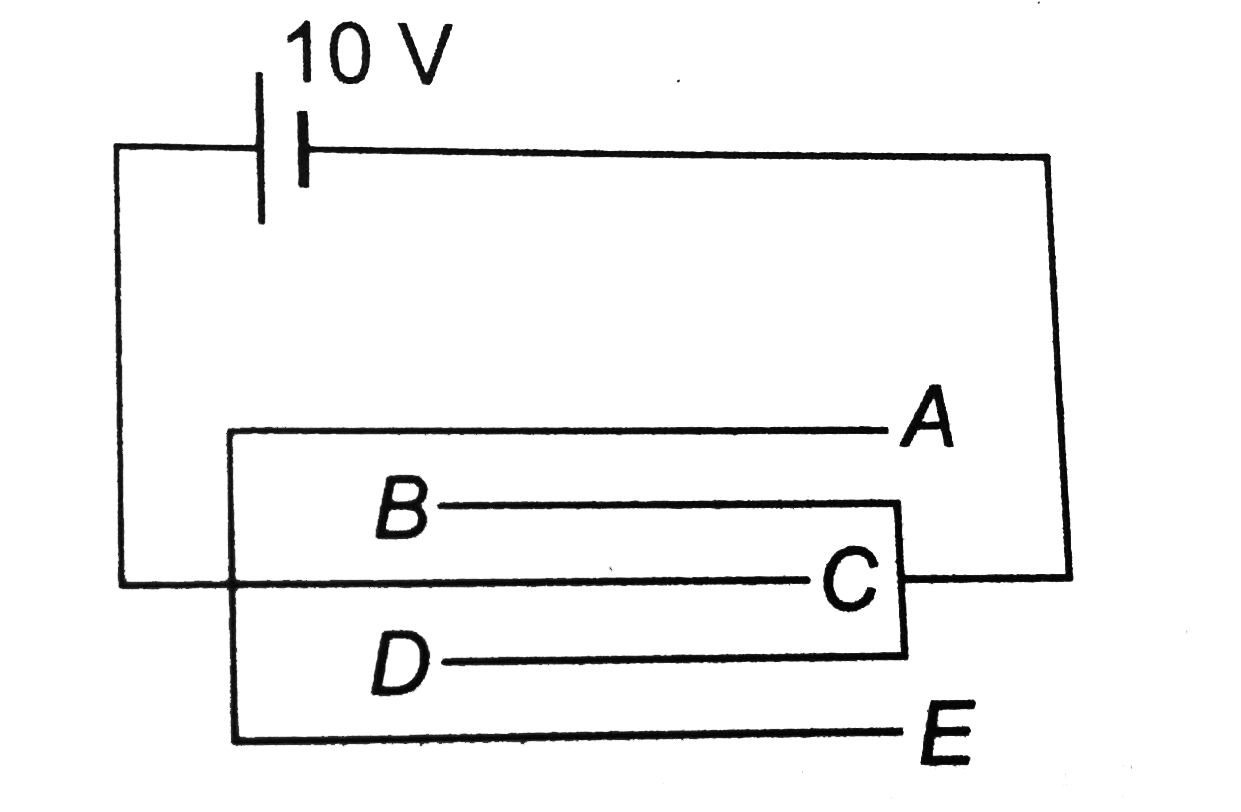Five identical conducting plates, and are fixed parallel pltes equidistant from each other (see figure). A conductor connects plates 2 and 5 while another conductor joins 1 and 3. The junction of 1 and 3 and the plate 4 are connected to a source of constant emf . Find

(a) the effective capacity of the system between the terminals of source.
(b) the charges on the plates 3 and 5. Given, distance between any two successive plates and area of either face of each plate.
i. The equivalent circuit is shown in. The system consists of four capacitors, i.e. , and . The capacity of each capacitor is

The capacitors and are in parallel, and their capacity is . The capacitor . is series with the parallel combination of and. Hence, the resultant capacity will be.
Further, is again in parallel with the combination , and . Hence, the effective capacity is
ii. Charge on plate 5 is equal to the charge on the upper half of the parallel combination. so
Charge on palte 3 on the surface facing 2 is equal to the potential differece across (3-2), i.e.,
Net charge on plate 3 is
.
Topper's Solved these Questions
- CAPACITOR AND CAPACITANCEBook:CENGAGE PHYSICSChapter:CAPACITOR AND CAPACITANCEExercise:Exercise 4.1
Explore 13 Videos
- CAPACITOR AND CAPACITANCEBook:CENGAGE PHYSICSChapter:CAPACITOR AND CAPACITANCEExercise:Exercise 4.2
Explore 32 Videos
- CAPACITOR AND CAPACITANCEBook:CENGAGE PHYSICSChapter:CAPACITOR AND CAPACITANCEExercise:Integer
Explore 5 Videos
- ATOMSBook:CENGAGE PHYSICSChapter:ATOMSExercise:QUESTION BANK
Explore 40 Videos
- CENGAGE PHYSICS DPPBook:CENGAGE PHYSICSChapter:CENGAGE PHYSICS DPPExercise:subjective type
Explore 51 Videos
Similar Questions
Five identical plates of equal area A are placed parallel to each other and at equal distance d from each other as shown in the figure. The effective capacity of the system between the terminals A and B is

View SolutionArea of each plate is A. The conducting plates are connected to a battery of emf V volts. Find charges q1 to qt.

View Solution
Knowledge Check
When a parallel plate capacitor is connected to a source of constant potential difference
Aall the charge drawn from source is stored in the capacitorBthe potential difference across capacitor grows very rapidly initially and this rate decreases to zero eventuallyConly half of the energy drawn from the source is dissipated outside the capacitorDall of theseFour identical metallic plates (1,2,3, and 4) are arranged in air at same distance d from each other with their outer plates being connected together and earthed. If the plates 2 and 3 are connected with a cell of constant emf E, then ratio of electric fields between the plate is
 AE1:E2:E3=23:1:23BE1:E2:E3=12:1:12Cand variation of electric potential will be
AE1:E2:E3=23:1:23BE1:E2:E3=12:1:12Cand variation of electric potential will be
 D
D
A parallel plate air-core capacitro is connected across a source of constant potential difference. When a dielectirc plate is introudced between the two plates then:
Asome charge form the capacitro will flow back into the sourceBsome extra charge form the source will flow back into the capacitorCthe electric filed intensity between the two plate does not chargeDthe electric field intensity between the two plates will decrease.
Each of the three plates shown in figure has an area of 200 cm^2 on one side and the gap between the adjacent plates is 0.2 mm. The emf of the battery is 20V. Find the distribution of charge on various surfaces of the plates. What is the equivalent capacitance of the system between the terminal points?

View SolutionThree capacitors 1, 2 and 4μ f are connected in series to a 10 volt source.The charge on the plate of middle capacitor is....
View SolutionA parallel plate capacitor is connected across a source of covstant potential difference. If a dielectric slab is introduced between the two plates, then
View SolutionFive identical capacitor plates are arranged such that they make four capacitors each of 2μF. The plates are connected to a source of emf 10V. The charge on plate C is

View SolutionThe terminals of a battery of emf V are connected to the two plates of a parallel plate capacitor. If the space between the plates of the capacitor is filled with an insulator of dielectric constant K, then :
View Solution

